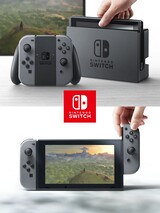Nintendo Switch: Difference between revisions
(Just to be a little more specific, because we've known about it for like two years now.) |
(→Features: Major misuse of controller. Also, that "different controller" is the pair of "joycon"s (eugh, by the way) plugged into a mounting unit. And never, EVER use Wikia as a ref.) |
||
| Line 10: | Line 10: | ||
==Features== | ==Features== | ||
[[File:Nintendo Switch Hardware.jpg|thumb|160px|left|An image depicting the Nintendo Switch's control methods.]] | [[File:Nintendo Switch Hardware.jpg|thumb|160px|left|An image depicting the Nintendo Switch's control methods.]] | ||
The game console will feature a main system that | The game console will feature a main system that can be plugged into a "Nintendo Switch Dock"<ref name="Nintendo.com article">http://www.nintendo.com/whatsnew/detail/first-look-at-nintendos-new-home-gaming-system</ref>. With the system docked, the game footage will be displayed on the TV screen. With the console detached, the footage will be displayed on the console's screen. The two "Joy-Con" controller pods can be removed and used either as separate controllers, similar to small [[Nintendo Entertainment System]] controllers, or used as one controller together, optionally docked into the "Joy-Con Grip"<ref name="Nintendo.com article" /> to give a more traditional experience. The console can be used without the docking unit, unlike the [[Wii U]]'s GamePad which it slightly resembles with Joy-Cons attached, making this console more of a hybrid between home and mobile systems. The console will also use small cartridges, similar to the [[Nintendo DS]] line. The base console also has two ports in the front, though it's currently unknown what they are for. | ||
The console has a kickstand that can be used to prop the system up. A traditional controller, simply called the Nintendo Switch Pro Controller<ref name="Nintendo.com article" />, will also have a Control Pad, replacing one set of the face buttons. | |||
Players can also link up multiple consoles to each other (four or the handheld systems were connected at a few points in the trailer) using wireless connectivity between the mobile screens and the base console can connect to others in some fashion (eight were connected during the ''Splatoon'' segment). | Players can also link up multiple consoles to each other (four or the handheld systems were connected at a few points in the trailer) using wireless connectivity between the mobile screens and the base console can connect to others in some fashion (eight were connected during the ''Splatoon'' segment). | ||
Revision as of 15:35, October 20, 2016
This article is about an upcoming console. Editors must cite sources for all contributions to this article. Edits that do not follow this standard may be reverted without notice.
This article is under construction. Therefore, please excuse its informal appearance while it is being worked on. We hope to have it completed as soon as possible.
The Nintendo Switch[1] (called the Nintendo NX in development) is Nintendo's upcoming home and mobile hybrid system, officially announced on October 20th, 2016 and set to be released in March of 2017.
Features
The game console will feature a main system that can be plugged into a "Nintendo Switch Dock"[2]. With the system docked, the game footage will be displayed on the TV screen. With the console detached, the footage will be displayed on the console's screen. The two "Joy-Con" controller pods can be removed and used either as separate controllers, similar to small Nintendo Entertainment System controllers, or used as one controller together, optionally docked into the "Joy-Con Grip"[2] to give a more traditional experience. The console can be used without the docking unit, unlike the Wii U's GamePad which it slightly resembles with Joy-Cons attached, making this console more of a hybrid between home and mobile systems. The console will also use small cartridges, similar to the Nintendo DS line. The base console also has two ports in the front, though it's currently unknown what they are for.
The console has a kickstand that can be used to prop the system up. A traditional controller, simply called the Nintendo Switch Pro Controller[2], will also have a Control Pad, replacing one set of the face buttons.
Players can also link up multiple consoles to each other (four or the handheld systems were connected at a few points in the trailer) using wireless connectivity between the mobile screens and the base console can connect to others in some fashion (eight were connected during the Splatoon segment).
Several Mario series amiibo were also shown in the trailer, though it wasn't shown how or even where to use them. With the reveal of The Legend of Zelda: Breath of the Wild at E3 2016, it was revealed that amiibo are compatible.
Revealed games
Among the games shown, a new 3D Mario platformer was revealed, showing Mario running around a town area, followed by a castle area. The town area has several, brightly-colored, buildings along with a creature resembling a Maraca Guy. The castle area has sand and water geysers around it, along with a Bill Blaster and Bullet Bill, as well as a number of Coin Rings and hearts indicating there is a health meter. It is currently unknown if this game will play out like Super Mario 64, Super Mario 3D World, or be a new type of platformer altogether.
In another game looking similar to Mario Kart 8, King Boo can be seen racing on GCN Yoshi Circuit, though it is unknown if he will be included as downloadable content for the original game (possibly hinting at backwards compatibility with the Wii U) or if it will be a new game entirely. It's also shown the player can use two items instead of one, like in older Mario Kart games.
External links
References
- ^ Cite error: Invalid
<ref>tag; no text was provided for refs namedFirstLook - ^ a b c http://www.nintendo.com/whatsnew/detail/first-look-at-nintendos-new-home-gaming-system
